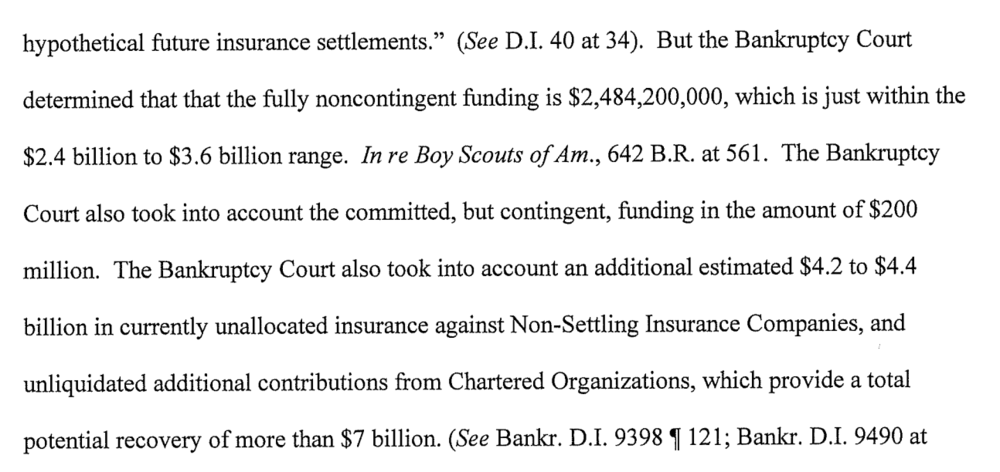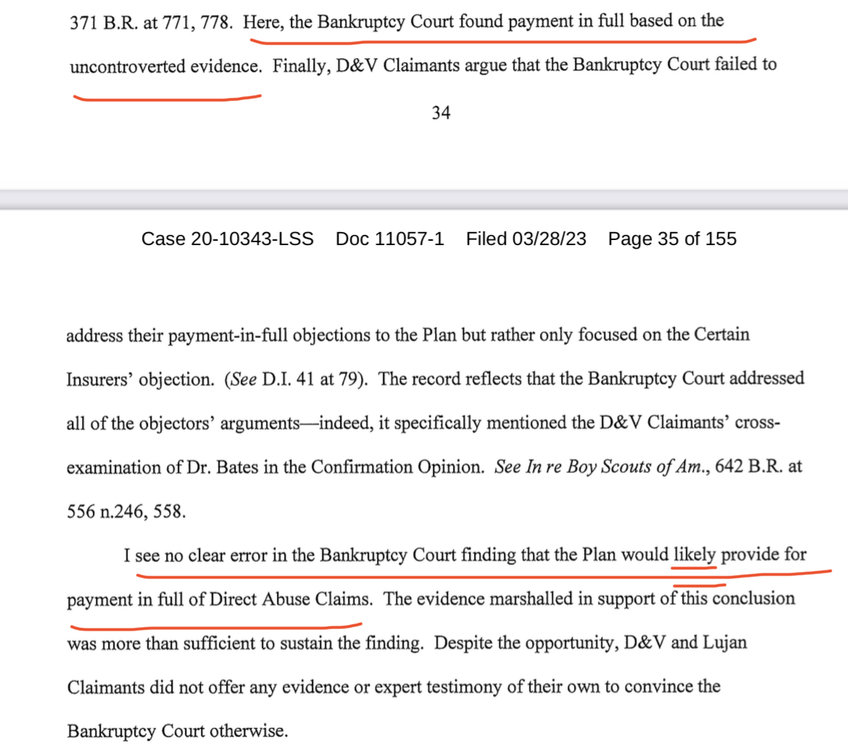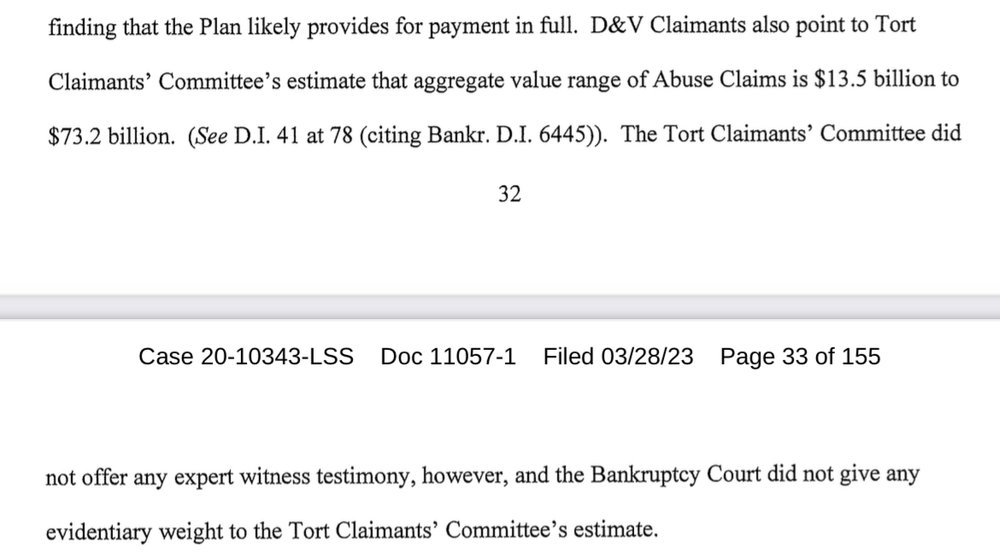
clbkbx
Members-
Posts
134 -
Joined
-
Last visited
-
Days Won
3
Content Type
Profiles
Forums
Articles
Store
Everything posted by clbkbx
-
Chapter 11 announced - Part 13 - Post District Court Affirmation
clbkbx replied to ThenNow's topic in Issues & Politics
Thank you for the clarification on the alternative path, I thought that was earlier in the process. The snippet above reads to me as: it's fully funded but... uhhh.... there is also potential additional funding. The Matrix amounts wrt known claims, the various expert estimates, the funding amounts, etc. just don't square with each other. -
Chapter 11 announced - Part 13 - Post District Court Affirmation
clbkbx replied to ThenNow's topic in Issues & Politics
That's a good point about the TCC supporting this version plan. I also wanted to note that, at this point, I'd like it to go into effect. You're also right about history fans: my recollection is that the TCC wailed that the settlements were "historically low" and then started to support the plan after the YPT sections were changed. That's always been a disconnect in my mind. [You've also heard me wail that youth protection had to be negotiated doesn't sit well.] I don't think what I posted is cherry picking. Both judges leaned on the Bates testimony. It's referenced repeatedly, presented as "payment in full" and then typically qualified, like so: "Payment in full... uncontroverted evidence" to "no clear error" that it will "likely provide for payment in full" in three sentences. I've posted this analysis before but... if you take the at least reasonable claims (no invalid votes, has to show a council) from the last vote (approx 43,000 claims), arrange them by claimed class, multiply by the matrix base (no scaling up or down) and weight by the SOL... the amount is $9.4B. Happy to share this or hear any feedback on the method. The Plan says that the "Trust Distribution Procedures’ Claims Matrix, Base Matrix Values, Maximum Matrix Values, and Scaling Factors.., are appropriate and provide for a fair and equitable settlement of Abuse Claims based on the evidentiary record offered to the Bankruptcy Court as required..." So the Trustee is going to have to find 75+% fraudulent claims, scale down every claim or (as I think most likely) not pay any where near the full value of the claims. I hope I'm wrong! -
Chapter 11 announced - Part 13 - Post District Court Affirmation
clbkbx replied to ThenNow's topic in Issues & Politics
-
Chapter 11 announced - Part 12 - District Court
clbkbx replied to Eagle1993's topic in Issues & Politics
Wouldn’t the LCs then be looking for bankruptcy protection individually as the lawsuits against them would move forward? I don’t think it’s quite like a non-culpable franchise member. -
Chapter 11 announced - Part 12 - District Court
clbkbx replied to Eagle1993's topic in Issues & Politics
It’s so odd to me that we have not heard anything from the TCC in a long time. I emailed them a few weeks ago and wrote: it’s been a month since the ruling, you’ve noted in the past that you’ve been locked out of negotiations, we are interested in what you think about the ruling, can we get an update? No response. -
Chapter 11 announced - Part 12 - District Court
clbkbx replied to Eagle1993's topic in Issues & Politics
Not certain this answers your question but you might look at the role of the Future Claimant’s Representative. They (at least) represent people who haven’t filed a claim due to age or repressed memories. -
Chapter 11 announced - Part 11 - Judge's Opinion
clbkbx replied to Eagle1993's topic in Issues & Politics
Third Modified Fifth Amended Thread -
Chapter 11 announced - Part 11 - Judge's Opinion
clbkbx replied to Eagle1993's topic in Issues & Politics
That is how the Settlement Trust Contribution payout timeline is determined. -
Chapter 11 announced - Part 11 - Judge's Opinion
clbkbx replied to Eagle1993's topic in Issues & Politics
There is a Settlement Trust Contribution from BSA that includes a note, cash, artwork, oil & gas leases, etc. (+/- $250 million is the most recent estimate I can find... not sure if that has been updated). After that is paid there is a Settlement Growth Payment (see #267 in the most recent plan), which I believe is what you are referencing. Up to $100 million additional based on membership rates above 1.5 million scouters or 0.5 million volunteers. The $100 million would be realized if they have 5.5% annual growth. -
Chapter 11 announced - Part 11 - Judge's Opinion
clbkbx replied to Eagle1993's topic in Issues & Politics
This is just what I wanted to know… is there a normal ratio of expenses to settlement amount? From what I’ve read and this discussion, it seems to vary quite a bit. -
Chapter 11 announced - Part 11 - Judge's Opinion
clbkbx replied to Eagle1993's topic in Issues & Politics
What’s a few zeros at this point?! You are, of course correct. It was something around $500 million. -
Chapter 11 announced - Part 11 - Judge's Opinion
clbkbx replied to Eagle1993's topic in Issues & Politics
Hi @fred8033... to the first question, I only know that's broken down in the filings including the by-firm table that was posted above which gives a good overall sense. I thought that in your initial post you were saying something along the lines of: an entity pays X fees to get to Y settlement (basically, what is BSA going to pay out of pocket to get through bankruptcy) and that X is normally 25-30% of Y. It seems like I might have been mistaken. For the second part, I think we are saying the same thing. The BSA is putting a certain amount ($500k iirc) into the Trust regardless of what payments they make to get through the process. Everything they pay out for the bankruptcy reduces what's they have available for operating going forward. -
Chapter 11 announced - Part 11 - Judge's Opinion
clbkbx replied to Eagle1993's topic in Issues & Politics
Thanks @fred8033. I didn't think the bottom two should be included when weighing the typical range but, like I said, I haven't been able to find any good reference for that. Administration is estimated around 10% and lawyer contingency fees are typically around 30% so right away you're at 40% not being paid out to survivors (assuming most are being represented by counsel). The BSA costs always seem to me to be about it's continued viability. They're not adding or subtracting to the amount they put into the Trust based on what it takes to get through bankruptcy. -
Chapter 11 announced - Part 11 - Judge's Opinion
clbkbx replied to Eagle1993's topic in Issues & Politics
I've often wondered this (what is a typical fee to settlement ratio) and never found a good source. If the above is normal, wouldn't the fees in this case be about 50% less than normal? $2.7B x 0.25 = $675MM and $2.7B x 0.3 = $810MM. Currently at $368MM. (BTW, I'm not a lawyer!) -
Chapter 11 announced - Part 11 - Judge's Opinion
clbkbx replied to Eagle1993's topic in Issues & Politics
Revised plan filed. Redline here: https://casedocs.omniagentsolutions.com/cmsvol2/pub_47373/7f73fba1-1980-4766-a6b3-d80e203fd73f_10263.pdf -
Chapter 11 announced - Part 11 - Judge's Opinion
clbkbx replied to Eagle1993's topic in Issues & Politics
Thanks. Two comments on the article. 1. I thought the case was going to be appealed. This article says it’s uncertain. I wonder if that’s just because of where the case is or if it not being appealed is a possible outcome. 2. One of the interviewees said “For some victims it’s a great result,” which is something I haven’t heard from anyone. Is there a scenario where someone is getting a great outcome? -
Chapter 11 announced - Part 11 - Judge's Opinion
clbkbx replied to Eagle1993's topic in Issues & Politics
The TCC today posted a "preliminary statement" at tccbsa.com. -
Chapter 11 announced - Part 11 - Judge's Opinion
clbkbx replied to Eagle1993's topic in Issues & Politics
I was wrong about this. The most recent version includes related entities. -
Chapter 11 announced - Part 11 - Judge's Opinion
clbkbx replied to Eagle1993's topic in Issues & Politics
I'm going to look at this again, but fairly certain the Bates report is only appropriate for a BSA-only approach. Basically, they said the historical settlement amounts were allocated as percentages to BSA National, LC's, CO's and others. Then they took the BSA National portion as the basis. But the LC's and CO's are being released. -
BSA CSA: Concealment or Trustworthy, Loyal...?
clbkbx replied to ThenNow's topic in Issues & Politics
I think if you check out Moral Panic: Changing Concepts of the Child Molester in Modern America by Philip Jenkins and some information from Stephen Robertson (Crimes Against Children is the book but some of that research is incorporated here if you have a library card: https://www.jstor.org/stable/40663407) you will see that there was a period, defined by Jenkins as the "Liberal Era" from 1958-1976, when what you are describing was the norm. It has changed over time more than you might expect including how it was prosecuted/charged (even as it's been a crime right since the founding of the various US states). -
BSA CSA: Concealment or Trustworthy, Loyal...?
clbkbx replied to ThenNow's topic in Issues & Politics
Not sure you could find worse examples for a CSA forum. -
BSA CSA: Concealment or Trustworthy, Loyal...?
clbkbx replied to ThenNow's topic in Issues & Politics
I know there are many different outcomes. My abuse was in the 90’s and he was arrested while still the SM. I guess I didn’t make an “official report” but as noted, not a word to me or my family. To other abuse victims (or those that would have knowledge): did BSA provide any counseling to you or to your knowledge? I guess to @elitts’s point, for instances after the 80’s. -
BSA CSA: Concealment or Trustworthy, Loyal...?
clbkbx replied to ThenNow's topic in Issues & Politics
I hear you on this. Sunlight is the best disinfectant, thank you for sharing some of your story. Every victim’s experience is difficult to read. If it’s not too burdensome to facilitate this conversation, I find your perspective is very valuable. -
BSA CSA: Concealment or Trustworthy, Loyal...?
clbkbx replied to ThenNow's topic in Issues & Politics
As I noted above, no one in BSA ever reached out to me. Here’s some more context: it was the late 1990’s (hope that doesn’t get counted as “old timer”!), my abuser was arrested (bc my family and I reported it to the police) so it was publicly known, I was in Scouts from Tiger through 18 yrs old, Eagle/Vigil/youth leadership positions so I knew/interacted with a lot of adults (SE on down). I never heard they did any reimbursement until recently (my broke college self could have used it more than now). That said, I’ve been considering it for my more recent during-bankruptcy therapy but haven’t… has anyone on here done that? -
BSA CSA: Concealment or Trustworthy, Loyal...?
clbkbx replied to ThenNow's topic in Issues & Politics
Sure, individual outcomes vary. That’s a lot different than, for example, what @johnsch322 noted about different outcomes based on reporting. National BSA was the correct entity to be aggregating (which they did) and analyzing (which it sure seems they didn’t) this information. I’ve made this comment before: that the last vote mainly changed YPT is outrageous. (I do hope the Neutral path helps some victims.) It shows me that BSA… having entered bankruptcy to address their past failures around CSA… are still prioritizing their org instead of youth. It’s embarrassing. The TCC explicitly said it was the reason to vote yes. That seems less like a negotiation and more like a hostage situation (vote for this or else…).







